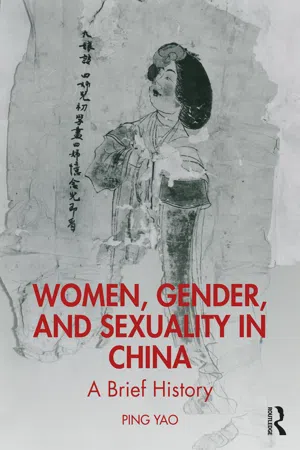
- 224 pages
- English
- ePUB (mobile friendly)
- Available on iOS & Android
About this book
Women, Gender and Sexuality in China: A Brief History serves as a focal textbook for undergraduate courses on women, gender, and sexuality in Chinese history. Thematically structured, it surveys important aspects of gender systems and gender practices throughout Chinese history, from the earliest period to the modern era. Topics include the concept of yin-yang, life course and gender roles, kinship systems and family structure, marriage practices, sexuality, women's work and daily life, as well as gender in Chinese mythology, religions, medicine, art, and literature. In narrating how various traditions and practices were formed and evolved throughout Chinese history, this textbook draws heavily on personal stories and historical records.
Features in this textbook include:
-
- Primary source sections for each chapter, introducing students to types of documents that have been used by scholars in conducting research
-
- Thirty-three translated texts of various genres, including epitaph, bronze inscription, medical text, imperial edict, legal case, family letter, ghost story, divorce paper, poetry, autobiography, etc.
-
- Dedicated biography sections for five distinguished women
Offering richly layered accounts of women, gender, and sexuality, this textbook is essential reading for students of Chinese history, gender in world history, or the comparative history of gender.
Frequently asked questions
- Essential is ideal for learners and professionals who enjoy exploring a wide range of subjects. Access the Essential Library with 800,000+ trusted titles and best-sellers across business, personal growth, and the humanities. Includes unlimited reading time and Standard Read Aloud voice.
- Complete: Perfect for advanced learners and researchers needing full, unrestricted access. Unlock 1.4M+ books across hundreds of subjects, including academic and specialized titles. The Complete Plan also includes advanced features like Premium Read Aloud and Research Assistant.
Please note we cannot support devices running on iOS 13 and Android 7 or earlier. Learn more about using the app.
Information
1 Life courses and gender roles
The conception of yin and yang

The principle of being ruler and subject, father and son, husband and wife all draws from the way of yin and yang. The ruler is yang and the subject is yin; the father is yang and the son is yin; the husband is yang and the wife is yin.7
Why is it that according to the Rites the man takes his wife, whereas the woman leaves her house? It is because the yin is lowly, and should not have the initiative; it proceeds to the yang in order to be completed.9
The way of establishing heaven is called yin and yang; the way of establishing earth is called gentle and tough. Yin and yang, gentle and tough, are the beginnings of heaven and earth. Male and female, husband and wife, are the beginnings of human social relations. … The wife is earth and the husband is heaven; neither can be dispensed with. But the man can perform a hundred actions; the woman concentrates on a single goal.11
The husband is heaven; the wife is earth. The husband is the sun; the wife is the moon. The husband is yang; the wife is yin. Heaven is honored and occupies the space above. Earth is lowly and occupies the space below. The sun does not vary in its fullness; the moon alternates between being round and being incomplete. Yang sings out and gives life to things; yin joins in and completes things. Therefore wives take as their virtues gentleness and compliance and do not excel through strength or intellectual discrimination.12
Prescribed life courses for men and women
When a girl is seven years of age, the emanations of the kidneys become abundant, she begins to change her teeth and her hair grows longer. When she reaches her fourteenth year she begins to menstruate and is able to become pregnant and the movement in the great thoroughfare pulse is strong. Menstruation comes at regular times, thus the girl is able to give birth to a child.When the girl reaches the age of twenty-one years the emanations of the kidneys are regular, the last tooth has come out, and she is fully grown. When the woman reaches the age of twenty-eight, her muscles and bones are strong, her hair has reached its full length and her body is flourishing and fertile.When the woman reaches the age of thirty-five, the pulse indicating [the region of] the “Sunlight” deteriorates, her face begins to wrinkle and her hair begins to fall. When she reaches the age of forty-two, the pulse of the three [regions of] Yang deteriorates in the upper part (of the body), her entire face is wrinkled and her hair begins to turn white.When she reaches the age of forty-nine she can no longer become pregnant and the circulation of the great thoroughfare pulse is decreased. Her menstruation is exhausted, and the gates of menstruation are no longer open; her body deteriorates and she is no longer able to bear children.13
Table of contents
- Cover
- Half-Title
- Title
- Copyright
- Contents
- Chronology of Chinese history
- Notes of conventions
- List of figures
- List of primary sources
- Introduction
- 1 Life courses and gender roles
- 2 Marriage and family
- 3 Sex, body, and medicine
- 4 Labor, profession, and everyday life
- 5 Religions
- 6 Arts, literature, and education
- 7 Five women to remember
- Glossary of Chinese characters
- Index